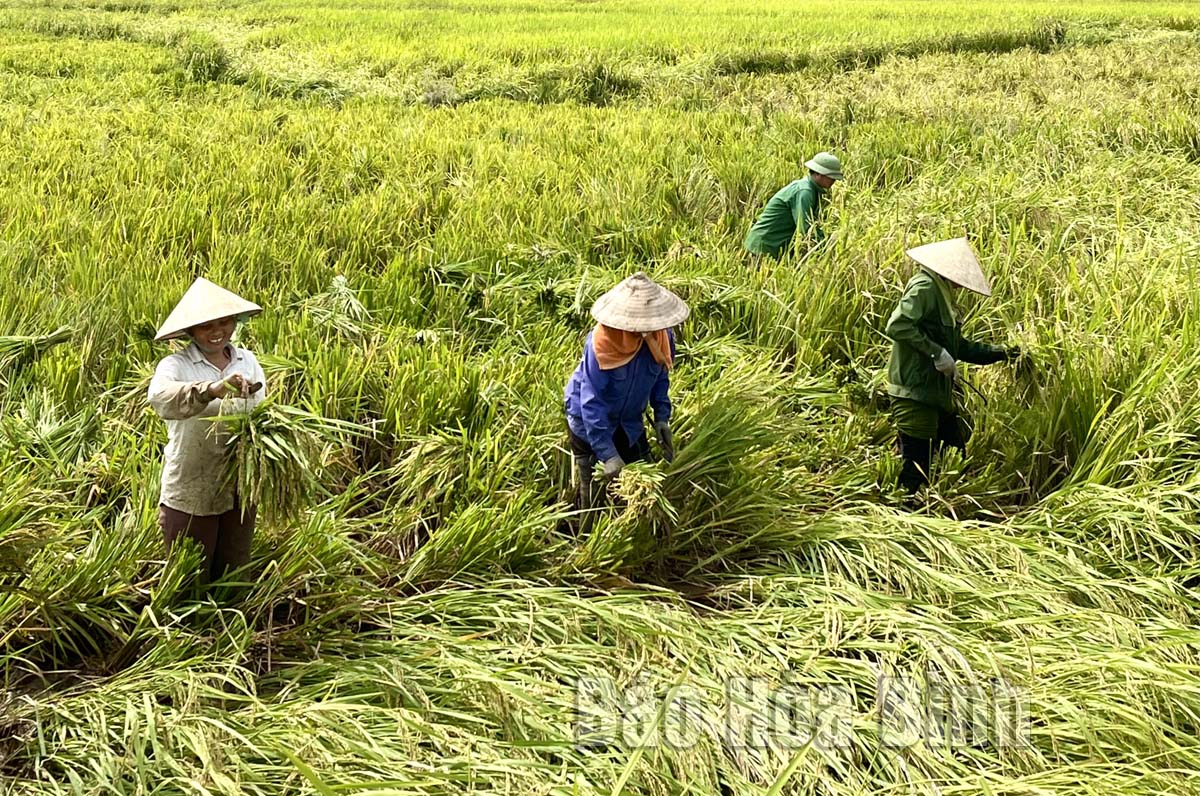
(HBO) - Thanks to the direction of the provincial authority and agricultural department, farmers in Hoa Binh have overcome challenges caused by the COVID-19 pandemic as well as plant and animal diseases to successfully complete the production plan for 2022 winter-spring crop.

Farmers in Kim Boi district’s Dong Bac commune harvest winter-spring rice.
Bui Thi Luong, a resident at Go Khanh hamlet, Kim Boi commune said they have
bumper crop this year. She attributed it to the proper care and the compliance
with the seasonal schedule and disease control under the guidance of local
agricultural officials.
Not only farmers in Kim Boi district but those in other localities in the
province also rejoiced because they got high yield in this crop. The average
yield is at 5.88 tonnes per hectare and total rice output of the province is
estimated at 97,000 tonnes, reaching 104.4 percent of the plan. Other crops
such as peanuts, cassava and vegetables all obtained high productivity and met
or exceeded the target.
According to the provincial Department of Agriculture and Rural Development,
favourable weather condition, the adoption of drastic measures in directing
production and proactiveness in restructuring of the agricultural sector at
localities have contributed to a successful winter-spring crop.
The department said the province strives to plant food crops on 44,300 hectares
for the summer-autumn crop, of which grain plants will cover 33,100 hectares.
Rice yield is expected to reach 5.3 tonnes per hectare while that of maize will
hit 4.4 tonnes per hectare.
In order to achieve good crops, the department asked localities
to promptly harvest winter-spring rice and other crops so as to early roll out
production plans for the summer-autumn crop, creating favourable conditions for
winter crop production.The cultivation area for crops with high economic
value should be expanded along with strengthening trade promotion activities
and sale of agricultural products, focusing on key products with export
advantages.
Favourable condition should be created for enterprises who invest in
agricultural production development in the province, the department said,
adding that localities should have specific plans to be ready to protect crops
given the complicated and unpredictable natural disasters./.
Hoa Binh province is undergoing a dynamic transformation amid Vietnam’s national digital transition. Building on Poliburo’s Resolution No. 57-NQ/TW on breakthroughs in science, technology, innovation, and national digital transformation, the province has rolled out a wide range of practical action plans. A standout initiative is the "Digital Literacy for All” movement, an effort to ensure that no one is left behind in the digital era.
Hoa Binh province is undergoing a dynamic transformation in the wake of the national digital transformation movement. Building on Resolution No. 57-NQ/TW of the Politburo on breakthroughs in science, technology, innovation, and national digital transformation, the province has implemented a wide range of practical action plans. A standout initiative is the "Digital Literacy for All” movement ambitious effort to ensure that no one is left behind in the digital age.
With a spirit of unity and proactive problem-solving, the Party Committee, the government and the people of Dong Lai Commune (Tan Lac District) have made great strides in implementing the resolutions of the 24th Party Congress of the commune for the 2020 - 2025 term. Focusing on leadership and practical actions, the commune has brought the Party’s resolutions into daily life, creating strong impacts and pushing the local development forward.
Amid the nationwide push for digital transformation, young people in Hoa Binh Province are stepping up as dynamic pioneers, applying technology to enhance Youth Union operations and expand the reach of youth-led initiatives. Through creativity and adaptability, Youth Union organizations at all levels have introduced a series of practical solutions, contributing to modern governance and community development.
In recent years, An Nghia commune, located in Lac Son district, has stepped up administrative reform, focusing on improving the quality and efficiency of its single-window service unit for receiving and processing administrative procedures. These improvements have helped create favourable conditions for local residents and organisations to handle administrative procedures, contributing to the commune’s broader socio-economic development.
The Prime Minister-approved master plan to develop the multi-use value of forests ecosystems through 2030, with a vision to 2050, aims to improve the management and sustainable use of forest resources, create jobs, increase incomes, and improve the living standards of ethnic minorities, people in mountainous and remote areas, forest workers and those living near forests.



